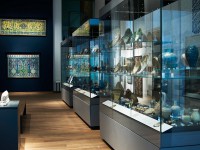Room 31 | Islamic Middle East gallery
Explore artefacts made over a period of more than 1000 years in the heart of the Islamic world.

‘They take ten parts of the ... white "sugar stone" [i.e. quartz] ... and one part of ground glass frit ... and one part of white ... clay dissolved in water. This is kneaded well like dough ... and left to mature for one night.'
(Description of the making of fritware in Abu'l Qasim's treatise on ceramics, about 1300)
The arrival in the 1100s of a new kind of Chinese porcelain set the Islamic potters off in a new direction. These porcelains were exquisitely thin and had delicate incised or moulded decoration.
Potters in the Islamic world were unable to make successful copies until they developed a type of fine ceramic known as fritware (or stonepaste). Largely made of ground quartz, this material was pure white, could be fashioned into thin-walled vessels, and was covered with a brilliant transparent glaze. Incised, moulded and painted decoration was creatively applied to the new body in the region stretching from Egypt to Syria and Iran.
 Jug with epigraphic decoration (EAX.3110)
Jug with epigraphic decoration (EAX.3110)
 Bowl with paired sphinxes and horsemen (EAX.1206)
Bowl with paired sphinxes and horsemen (EAX.1206)
 Bowl with high foot and incised floral decoration (EA2002.1)
Bowl with high foot and incised floral decoration (EA2002.1)
 Jug with human-headed birds paired in roundels (EA1978.2232)
Jug with human-headed birds paired in roundels (EA1978.2232)
 Jug with epigraphic decoration (EA1978.2236)
Jug with epigraphic decoration (EA1978.2236)
 Ewer with chain-like decoration and faceted spout (EA1978.2275)
Ewer with chain-like decoration and faceted spout (EA1978.2275)
 Bowl with vegetal decoration (EA1956.44)
Bowl with vegetal decoration (EA1956.44)
Underglaze painted wares
Underglaze decoration in more than one colour had been one of the challenges of Islamic potters. The 1100s saw the gradual development of underglaze painting techniques – from the covering of vessels with a black slip that was subsequently removed to reveal the pattern (‘silhouette’ ware) to the achievement of full control over thin pigments which would not run during the firing. The earliest dated examples of this kind are of the early 1200s.
 Bowl with seated figure (EA1956.22)
Bowl with seated figure (EA1956.22)
 Bowl with animals against a foliate background (EA1956.29)
Bowl with animals against a foliate background (EA1956.29)
 Lobed bowl (EA1956.92)
Lobed bowl (EA1956.92)
 Beaker with epigraphic decoration (EA1956.60)
Beaker with epigraphic decoration (EA1956.60)
 Bowl with pseudo-calligraphic and vegetal decoration (EA1978.2188)
Bowl with pseudo-calligraphic and vegetal decoration (EA1978.2188)
 Fragment of a dish with peacock (EA1978.2177)
Fragment of a dish with peacock (EA1978.2177)
Notice
Objects may have since been removed or replaced from a gallery. Click into an individual object record to confirm whether or not an object is currently on display. Our object location data is usually updated on a monthly basis, so contact the Jameel Study Centre if you are planning to visit the museum to see a particular Eastern Art object.
© 2013 University of Oxford - Ashmolean Museum





